uigridlayout
Create grid layout manager
Syntax
Description
g = uigridlayoutGridLayout object. MATLAB® calls the uifigure function to create the figure. Use
a grid layout manager if you do not want to position components by setting pixel values in
Position vectors.
If you add components to the grid layout manager, but you do not specify the
Layout property of the components, then the grid layout manager adds
the components from left to right and then top to bottom.
g = uigridlayout(parent)Figure object or one of its child containers.
g = uigridlayout(___,Name,Value)GridLayout property values using one or more name-value pair
arguments. Specify the name-value pair arguments after all other arguments in any of the
previous syntaxes.
Examples
Create a figure and a grid. Then configure the grid by setting the row heights and column widths. In this case, configure a 3-by-2 grid in which the top two rows are fixed at 22 pixels, while the bottom row has a variable height. Set the left column to be 150 pixels wide, and set the right column to have a variable width. The grid fills the entire figure, but because the grid is invisible, the figure appears to be empty.
fig = uifigure('Position',[100 100 440 320]); g = uigridlayout(fig); g.RowHeight = {22,22,'1x'}; g.ColumnWidth = {150,'1x'};
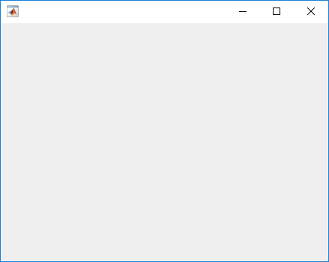
Add two drop-downs, a list box, and an axes component to the grid. If you do not
specify row or column locations for the Layout property of
components, they populate the grid from left to right and top to bottom by default. In
this case, move the second drop-down (dd2) and the list box
(chanlist) to specific rows and columns by setting the
Layout property.
% Device drop-down dd1 = uidropdown(g); dd1.Items = {'Select a device'}; % Range drop-down dd2 = uidropdown(g); dd2.Items = {'Select a range'}; dd2.Layout.Row = 2; dd2.Layout.Column = 1; % List box chanlist = uilistbox(g); chanlist.Items = {'Channel 1','Channel 2','Channel 3'}; chanlist.Layout.Row = 3; chanlist.Layout.Column = 1; % Axes ax = uiaxes(g);

Set the axes to span rows 1 through 3, filling the vertical space.
ax.Layout.Row = [1 3];

When you resize the figure, the axes grow and shrink to fill the available space
that the left column does not use. The components on the left side remain fixed because
that column is defined as 150 pixels wide.

When you assign different weights to variable-width columns, the width of each column is proportional to the weight. Variable-height rows allocate space the same way.
Create a figure and a 2-by-2 grid. Then configure the row heights and the column widths. In this case, the top row is fixed at 40 pixels, while the bottom row has a variable height. Both columns have a variable width, but the second column has twice the weight of the first column. Because the grid is invisible, the figure appears to be empty.
fig = uifigure('Position',[100 100 437 317]); g = uigridlayout(fig,[2 2]); g.RowHeight = {40,'1x'}; g.ColumnWidth = {'1x','2x'};

Add a label across both columns of the top row. Then add an axes component to each column of the bottom row.
% Add title title = uilabel(g,'Text','Market Trends'); title.HorizontalAlignment = 'center'; title.FontSize = 24; title.Layout.Row = 1; title.Layout.Column = [1,2]; % Add two axes ax1 = uiaxes(g); ax2 = uiaxes(g);
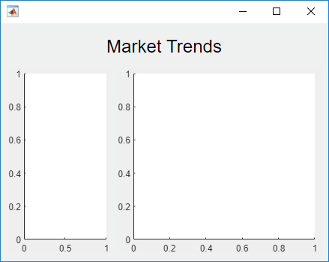
Because the left column has a weight of 1, and the right column
has a weight of 2, the axes on the right use twice as much of the
horizontal space as the axes on the left. The grid maintains this ratio when you resize
the figure.
One way to arrange UI components in a panel is to create a grid in the panel.
Create a figure and a 1-by-2 grid. Then configure the column widths. In this case,
the left column is fixed at 220 pixels, while the right column has a
variable width. Because the grid is invisible, the figure appears to be empty.
fig = uifigure('Position',[100 100 500 315]); grid1 = uigridlayout(fig,[1 2]); grid1.ColumnWidth = {220,'1x'};
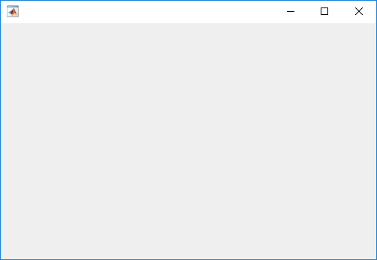
Add a panel and axes to grid1.
p = uipanel(grid1,'Title','Configuration'); ax = uiaxes(grid1);
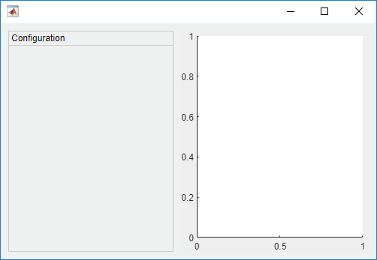
Create a grid called grid2 inside the panel. Then place three
components and three labels inside grid2. The left column of
grid2 aligns the labels with the components. Since each row uses
only 22 pixels, the panel has extra space below the third row.
% Grid in the panel grid2 = uigridlayout(p,[3 2]); grid2.RowHeight = {22,22,22}; grid2.ColumnWidth = {80,'1x'}; % Device label dlabel = uilabel(grid2); dlabel.HorizontalAlignment = 'right'; dlabel.Text = 'Device'; % Device drop-down devicedd = uidropdown(grid2); devicedd.Items = {'Select a device'}; % Channel label chlabel = uilabel(grid2); chlabel.HorizontalAlignment = 'right'; chlabel.Text = 'Channel'; % Channel drop-down channeldd = uidropdown(grid2); channeldd.Items = {'Channel 1', 'Channel 2'}; % Rate Label ratelabel = uilabel(grid2); ratelabel.HorizontalAlignment = 'right'; ratelabel.Text = 'Rate (scans/s)'; % Rate edit field ef = uieditfield(grid2, 'numeric'); ef.Value = 50;

When you resize the figure, the axes grow and shrink to fill the available space
that the left column of grid1 does not use. The panel remains fixed
because that column is defined as 220 pixels wide.

Nested grids allow you to manage subsets of components. In this case, there are three grids: one grid that covers the entire figure, a second grid that manages a vertical stack of components, and a third grid that manages two buttons that are side by side at the bottom of the vertical stack.
Create a figure and a 1-by-2 grid. Then configure the column widths. In this case,
the left column is fixed at 150 pixels, while the right column has a
variable width. Because the grid is invisible, the figure appears to be empty.
fig = uifigure('Position',[100 100 500 315]); grid1 = uigridlayout(fig,[1 2]); grid1.ColumnWidth = {150,'1x'};
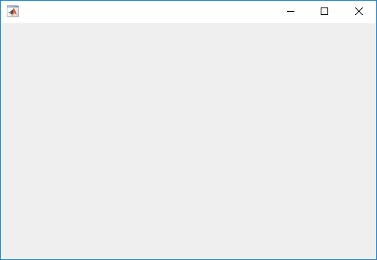
Create a 4-by-1 grid called grid2 inside the first column of
grid1. Then add an axes component to the second column of
grid1.
grid2 = uigridlayout(grid1,[4 1]);
grid2.RowHeight = {22,22,22,44};
ax = uiaxes(grid1);

Add three drop-downs to the first three rows of grid2.
% Routes drop-down ddRoutes = uidropdown(grid2); ddRoutes.Items = {'Route 1', 'Route 2'}; % Direction drop-down ddDirection = uidropdown(grid2); ddDirection.Items = {'Inbound', 'Outbound'}; % Time drop-down ddTime = uidropdown(grid2); ddTime.Items = {'Morning', 'Afternoon'};
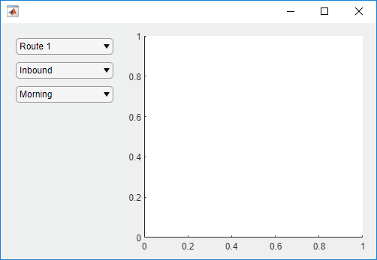
Create a 1-by-2 grid called grid3 inside the last row of
grid2. Then add two buttons to grid3. Remove the
padding on the left and right edges of grid3 so that the buttons
align with the left and right edges of the drop-downs.
grid3 = uigridlayout(grid2,[1 2]); grid3.Padding = [0 10 0 10]; b1 = uibutton(grid3,'Text','Start'); b2 = uibutton(grid3,'Text','Stop');
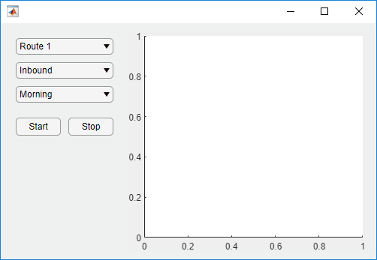
When you resize the figure, the axes grow and shrink to fill the available space
that the left column of grid1 does not use. The components on the
left side remain fixed because that column is defined as 150 pixels
wide.

Bring child components of a scrollable grid layout into view by specifying pixel coordinates or a location name.
Create a 5-by-2 grid layout and set the Scrollable property
of the grid to 'on'. Then add a label, a table, and a panel to
the grid. Set the Scrollable property of the panel to
'off' and then add a chart to the panel.
fig = uifigure('Position',[782 497 435 311]); g = uigridlayout(fig,'Scrollable','on'); g.RowHeight = {22,40,22,22,400}; g.ColumnWidth = {400,400}; lbl = uilabel(g,'Text','Tsunamis'); lbl.Layout.Row = 2; lbl.Layout.Column = [1,2]; lbl.HorizontalAlignment = 'center'; lbl.FontSize = 28; tsunamis = readtable('tsunamis.xlsx'); tsunamis.Cause = categorical(tsunamis.Cause); t = uitable(g,'Data',tsunamis); t.Layout.Row = [3,5]; t.Layout.Column = 2; p = uipanel(g); p.Scrollable = 'off'; p.Layout.Row = [3,5]; p.Layout.Column = 1; gb = geobubble(p,tsunamis.Latitude,tsunamis.Longitude,... tsunamis.MaxHeight,tsunamis.Cause);

Scroll to a location in the grid.
scroll(g,100,-30)

Now use location names to scroll to the bottom-right corner of the grid.
scroll(g,'bottom','right')

Create a grid layout manager that automatically adjusts its row and column sizes to fit components like labels as you add them to your app, or when the font size of text-based components changes dynamically.
Create a 5-by-2 grid layout manager. Specify 'fit' for the first
column width and the first four row heights.
fig = uifigure('Position',[500 500 430 310]); g = uigridlayout(fig); g.ColumnWidth = {'fit',120,'1x'}; g.RowHeight = {'fit','fit','fit','fit','1x'};
Create a title label that spans all the columns. Then, create labels and controls
along the rows of the first and second columns. Lastly, create a table UI component in
the last column that spans rows two through five. Notice that as you add components to
the rows and columns with 'fit' height and width, the size of those
row and columns automatically adjusts to fit the new content.
patientLabel = uilabel(g,'Text','Patient:'); patientLabel.Layout.Row = 2; patientLabel.Layout.Column = 1; patientEdit = uieditfield(g); ageLabel = uilabel(g,'Text','Age:'); ageLabel.Layout.Row = 3; ageLabel.Layout.Column = 1; ageEdit = uidropdown(g,'Items',{'<20','20 - 40','40 - 60','>60'}); stateLabel = uilabel(g,'Text','State:'); stateLabel.VerticalAlignment = 'top'; stateLabel.Layout.Row = 4; stateLabel.Layout.Column = 1; stateLB = uilistbox(g,'Items',{'MA','VA','WY'}); tdata = readtable('patients.dat'); uit = uitable(g); uit.Data = tdata; uit.Layout.Row = [2 5]; uit.Layout.Column = 3;
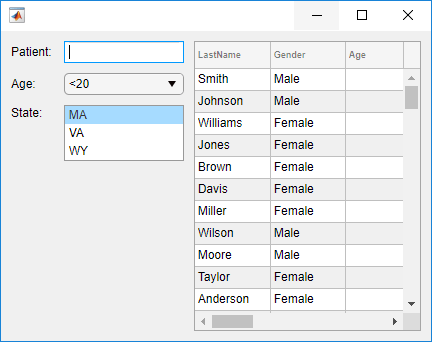
Now, change the font name and font size of all the UI components in the grid.
set(allchild(g),'FontName','Lucida Console','FontSize',20)
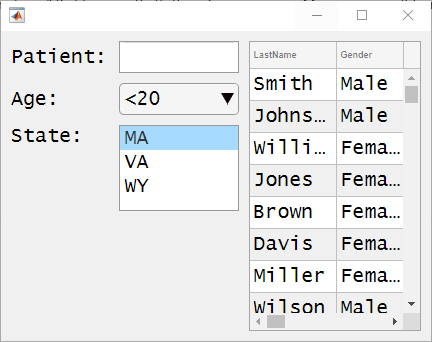
Hide components within a row of a grid based on the user's selection in a drop-down menu.
Create a program file called showhide.m. In the file,
Create a 1-by-2 grid in the figure and call it
grid1. Use this grid to manage a panel and an axes component.Create a 3-by-2 grid inside the panel and call it
grid2. Use this grid to manage the layout of a drop-down menu, two spinners, and their labels.Create a callback function called
findMethodSelectedfor the drop-down menu. When the value of the drop-down menu changes to'Quartiles', the callback hides the components in a second row ofgrid2by settinggrid2.RowHeight{2}to0.
Then, run the file.
function showhide f = uifigure('Name','Statistical Analysis'); % Create grid1 in the figure grid1 = uigridlayout(f); grid1.RowHeight = {'1x'}; grid1.ColumnWidth= {220,'1x'}; % Add a panel and axes p = uipanel(grid1); ax = uiaxes(grid1); % Create grid2 in the panel grid2 = uigridlayout(p); grid2.RowHeight = {22, 22, 22}; grid2.ColumnWidth = {80,'1x'}; % Add method label and drop-down findMethodLabel = uilabel(grid2,'Text','Find Method:'); findMethod = uidropdown(grid2); findMethod.Items = {'Moving median','Quartiles'}; findMethod.ValueChangedFcn = @findMethodSelected; % Add window size label and spinner winSizeLabel = uilabel(grid2,'Text','Window Size:'); winSize = uispinner(grid2,'Value',0); % Add threshold label and spinner thresLabel = uilabel(grid2,'Text','Threshold:'); thres = uispinner(grid2,'Value',3); function findMethodSelected(src,~) method = src.Value; switch method case 'Quartiles' % Collapse the second row (hides winSize spinner) grid2.RowHeight{2} = 0; case 'Moving median' % Expand the second row grid2.RowHeight{2} = 22; end end end
When you set the Find Method to Quartiles in the app, the Window Size label and the spinner next to it become hidden.
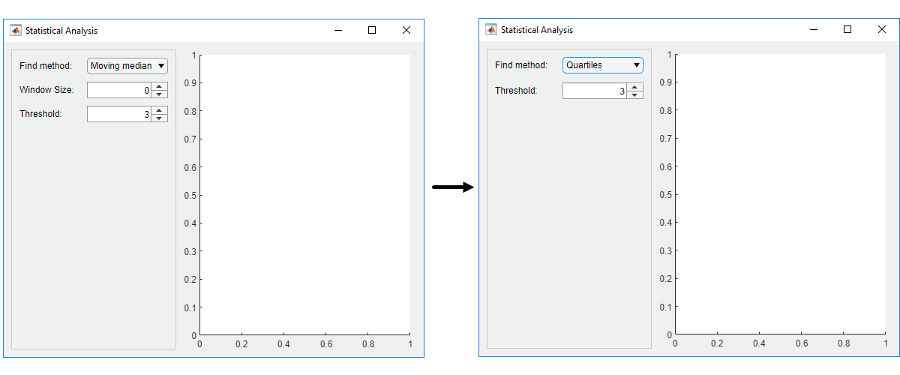
Input Arguments
Parent container, specified as a Figure object or
one of its child containers: Tab, Panel, ButtonGroup, or
GridLayout. If you do not specify a parent
container, MATLAB calls the uifigure function to create a new Figure object that serves as the parent container.
Size of the grid, specified as a two-element vector. The first element is the number
of rows, and the second element is the number of columns. Both values must be greater
than 0. When you specify this argument without setting the
RowHeight or ColumnWidth properties,
MATLAB automatically sets the row heights and column widths to
'1x'.
Name-Value Arguments
Specify optional pairs of arguments as
Name1=Value1,...,NameN=ValueN, where Name is
the argument name and Value is the corresponding value.
Name-value arguments must appear after other arguments, but the order of the
pairs does not matter.
Before R2021a, use commas to separate each name and value, and enclose
Name in quotes.
Example: uigridlayout('RowHeight',{100,100}) creates a grid containing
two rows that are 100 pixels in height.
Note
The properties listed here are only a subset. For a complete list, see GridLayout.
Column width, specified as a cell array containing either 'fit',
numbers, or numbers paired with 'x' characters. You can specify any
combination of values. The number of elements in the cell array controls the number of columns
in the grid. For example, to create a 4-column grid, specify a 1-by-4 cell array. Column width
can be specified as a string array or numeric array, only if the elements specified are of the
same type, like ["1x" "2x" "1x"] or [100 200 50].
There are three different types of column widths:
Fit width — Specify
'fit'. Column width automatically adjusts to fit its contents. For text-based components,'fit'width adjusts with font properties to show the whole text. For non text-based components,'fit'width is based on the default size of the component and other factors. Use'fit'width if you want to avoid hard-coding the column width to fit components, or if your app is translated to another language or runs on different platforms.Fixed width in pixels — Specify a number. The column width is fixed at the number of pixels you specify. When the parent container resizes, the column width does not change.
Variable width — Specify a number paired with an
'x'character (for example,'1x'). When the parent container resizes, the column width grows or shrinks. Variable-width columns fill the remaining horizontal space that the fixed-width columns do not use. The number you pair with the'x'character is a weight for dividing up the remaining space among all the variable-width columns. If the grid has only one variable-width column, then it uses all the remaining space regardless of the number. If there are multiple variable-width columns that use the same number, then they share the space equally. Otherwise, the amount of space is proportional to the number.
For example, {'fit',200,'2x','1x'} specifies that the width of the
first column is sized to fit its content, the second column is fixed at 200 pixels, and the
last two columns share the remaining horizontal space. The third column uses twice as much
space as the fourth column.
Changing certain aspects of a layout can affect the value of this property. For example, adding more components to a fully populated grid changes the size of the grid to accommodate the new components.
Changing the ColumnWidth property on a grid layout that already
contains components does not change the layout of the components. For example, if you try to
dynamically delete a column that contains components, the ColumnWidth
property does not change until you move those components out of that column.
Row height, specified as a cell array containing either 'fit', numbers,
or numbers paired with 'x' characters. You can specify any combination of
values. The number of elements in the cell array controls the number of rows in the grid. For
example, to create a grid that has 4 rows, specify a 1-by-4 cell array. Row height can be
specified as a string array or numeric array, only if the elements specified are of the same
type, like ["1x" "2x" "1x"] or [100 200 50].
There are three different types of row heights:
Fit height — Specify
'fit'. Row height automatically adjusts to fit its contents. For text-based components,'fit'height adjusts with font properties to show the whole text. For non text-based components,'fit'height is based on the default size of the component and other factors. Use'fit'height if you want to avoid hard-coding the row height to fit components, or if your app is translated to another language or runs on different platforms.Fixed height in pixels — Specify a number. The row height is fixed at the number of pixels you specify. When the parent container resizes, the row height does not change.
Variable height — Specify a number paired with an
'x'character (for example,'1x'). When the parent container resizes, the row grows or shrinks. Variable-height rows fill the remaining vertical space that the fixed-height rows do not use. The number you pair with the'x'character is a weight for dividing up the remaining space among all the variable-height rows. If the grid has only one variable-height row, then it uses all the remaining space regardless of the number. If there are multiple variable-height rows that use the same number, then they share the space equally. Otherwise, the amount of space is proportional to the number.
For example, {'fit',200,'2x','1x'} specifies that the height of the
first row is sized to fit its content, the second row is fixed at 200 pixels, and the last two
rows share the remaining vertical space. The third row uses twice as much space as the fourth
row.
Changing certain aspects of a layout can affect the value of this property. For example, adding more components to a fully populated grid changes the size of the grid to accommodate the new components.
Changing the RowHeight property on a grid layout that already
contains components does not change the layout of the components. For example, if you try to
dynamically delete a row that contains components, the RowHeight property
does not change until you move those components out of that row.
This property is read-only.
Location and size of the grid layout manager, returned as a four-element vector of the form [left bottom width height]. This table describes each element in the vector.
| Element | Description |
|---|---|
left | Distance from the inner left edge of the parent container to the left edge of the grid layout manager |
bottom | Distance from the inner bottom edge of the parent container to the bottom edge of the grid layout manager |
width | Distance between the left and right edges of the grid layout manager |
height | Distance between the bottom and top edges of the grid layout manager |
All measurements are in pixel units.
This image shows the areas defined by the Position value (orange solid
line) and the InnerPosition value (blue
dashed line) of a grid layout manager with some UI
components.

Tips
To view the list of component objects in the grid, query the
Childrenproperty of the grid. Changing the order in the list does not change the layout in the grid.You can query the
Positionproperty of a component object in the grid to determine its location and size, but the property value is not immediately updated when the component is added to the grid.
Version History
Introduced in R2018bUse the Position, InnerPosition, and
OuterPosition properties of a grid layout manager to access its
location and size. These properties are read-only.
Grid layout managers with row heights or column widths of 'fit' now
resize to fit the contents of table, list box, and image UI components.
In previous releases, grid layout managers with row heights or column widths of
'fit' scaled to a fixed size when the row or column contained a table,
list box, or image UI component.
Table UI component — Row height and column width previously resized to 300 pixels.
List box UI component — Row height previously resized to display at most four items. The exact pixel value to display four items might vary depending on your settings.
Image UI component — Row height and column width previously resized to 100 pixels.
To display a table, list box, or image at its size in a release before R2022a, set the
corresponding elements of the RowHeight and
ColumnWidth properties of the GridLayout object to
their respective fixed sizes.
Starting in R2020b, GridLayout objects have a
BackgroundColor property and are no longer transparent. The default
background color is the default color for all containers (for example, figures and
panels).
If your app has a grid layout in a container that has a nondefault color, then set the
BackgroundColor property of the GridLayout object
to that color to preserve the appearance of your app.
If your app has objects behind the grid that you want to remain visible, move those
objects into the grid by making them children of the GridLayout.
See Also
Functions
Properties
Tools
MATLAB Command
You clicked a link that corresponds to this MATLAB command:
Run the command by entering it in the MATLAB Command Window. Web browsers do not support MATLAB commands.
Sélectionner un site web
Choisissez un site web pour accéder au contenu traduit dans votre langue (lorsqu'il est disponible) et voir les événements et les offres locales. D’après votre position, nous vous recommandons de sélectionner la région suivante : .
Vous pouvez également sélectionner un site web dans la liste suivante :
Comment optimiser les performances du site
Pour optimiser les performances du site, sélectionnez la région Chine (en chinois ou en anglais). Les sites de MathWorks pour les autres pays ne sont pas optimisés pour les visites provenant de votre région.
Amériques
- América Latina (Español)
- Canada (English)
- United States (English)
Europe
- Belgium (English)
- Denmark (English)
- Deutschland (Deutsch)
- España (Español)
- Finland (English)
- France (Français)
- Ireland (English)
- Italia (Italiano)
- Luxembourg (English)
- Netherlands (English)
- Norway (English)
- Österreich (Deutsch)
- Portugal (English)
- Sweden (English)
- Switzerland
- United Kingdom (English)